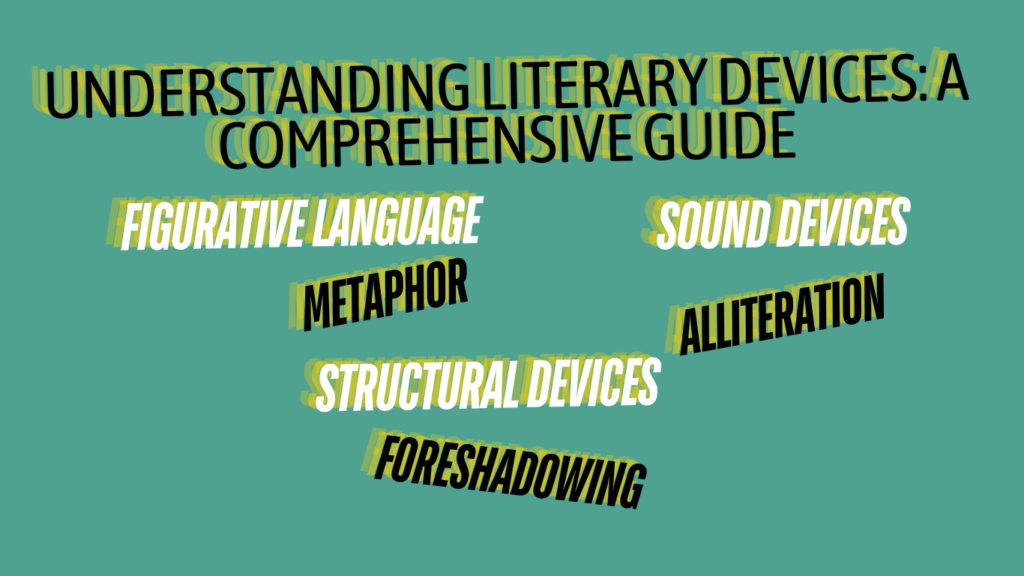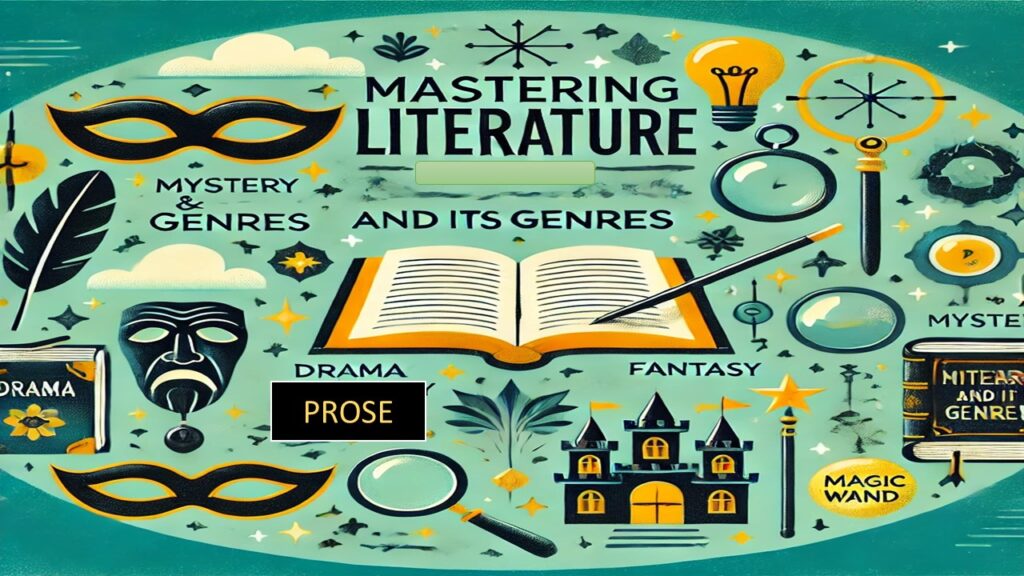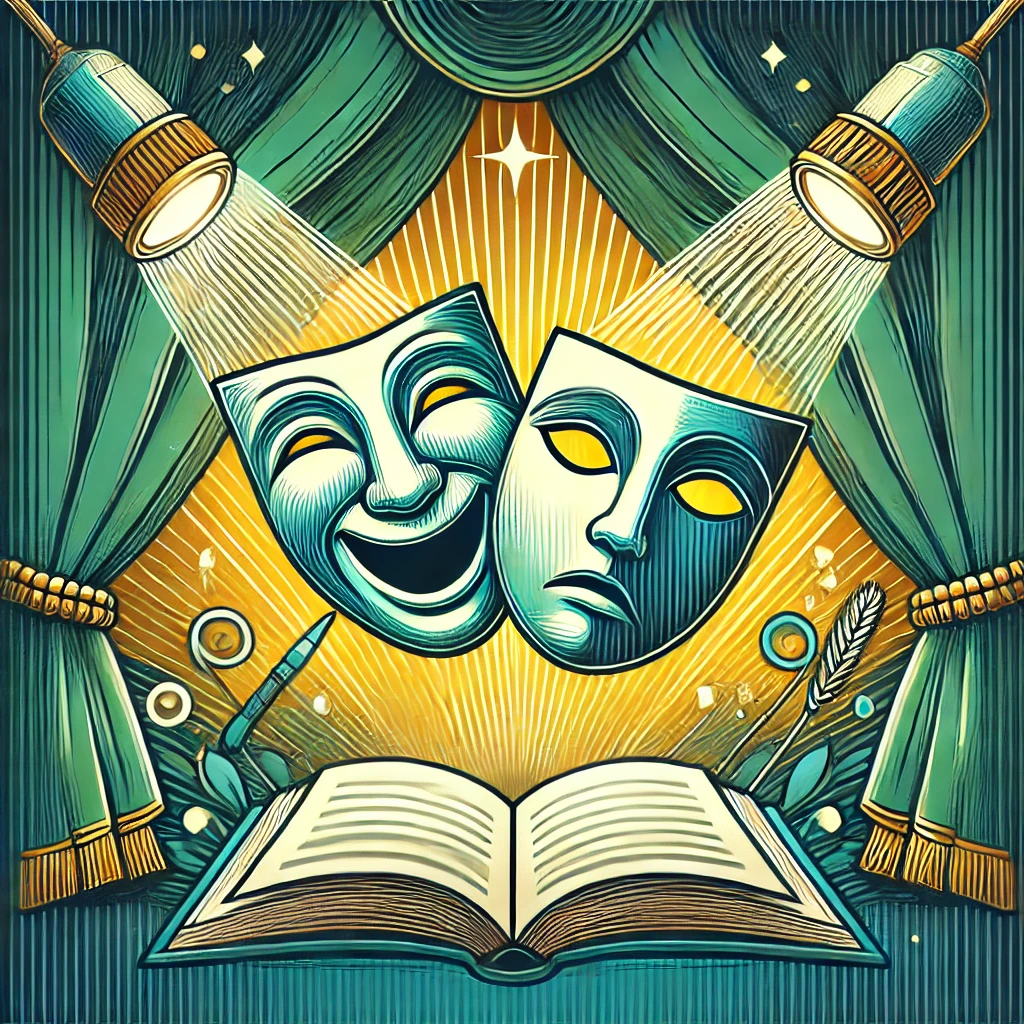Unlocking the Power of Literary Devices: A Simple Guide to Enhance Your Writing
Literary devices are the tools writers use to craft their stories, poems, and essays. These tools enhance the reader’s experience by adding depth, complexity, and layers of meaning to the text. What would we do wthout metaphors that create vivid imagery or irony that adds an unexpected twist, These literary devices are central to the art of storytelling. In this article, Understanding Literary Devices: A Comprehensive Guide, we will explore the most common literary devices, how they work, and examples of their usage. We will also examine how these devices contribute to the themes and messages in literature.
1. Introduction to Literary Devices
Definition and Importance
Literary devices are techniques used by writers to convey their ideas and enhance their storytelling. They are the methods by which an author engages the reader, making the text more vivid, persuasive, and memorable. These devices range from simple techniques like similes and metaphors to more complex structures like allegories and stream of consciousness.
Historical Context
The use of literary devices can be traced back to the earliest forms of storytelling. Ancient texts like The Iliad and The Odyssey are rich with similes, metaphors, and other devices that have been studied for centuries. Shakespeare’s plays, known for their use of irony and wordplay, are quintessential examples of how literary devices can elevate a narrative.
Overview of Types
Literary devices can be broadly categorized into several types:
Figurative Language: These are techniques that create comparisons or add layers of meaning beyond the literal.
Sound Devices: These refer to methods that focus on how words sound to make the text more engaging or impactful.
Structural Devices: They are techniques that relate to the organization and structure of the text.
Narrative Techniques: They refer to methods that influence the narrative voice and point of view.
Thematic Devices: These are techniques that reinforce themes and underlying messages.
Rhetorical Devices: Persuasive techniques used to strengthen arguments and engage the audience.
2. Figurative Language
Simile
A simile is a comparison between two unlike things using the words “like” or “as.” This device is used to create a vivid image in the reader’s mind by linking familiar concepts with unfamiliar ones. For example, in Robert Burns’ poem “A Red, Red Rose,” he writes, “O my Luve is like a red, red rose.” The comparison of love to a rose conveys beauty, fragility, and passion.
Metaphor
Metaphors are another form of comparison, but unlike similes, they do not use “like” or “as.” Instead, a metaphor asserts that one thing is another, creating a direct and often more powerful image. William Shakespeare’s As You Like It contains the famous metaphor, “All the world’s a stage, and all the men and women merely players.” Here, life is equated with a play, emphasizing the performative aspects of human behavior. ”
- The classroom was a zoo.” – Compares the chaotic classroom to a zoo, suggesting disorder
Personification
Personification assigns human characteristics to non-human entities. This device is often used in poetry and literature to evoke empathy and bring inanimate objects to life. In John Keats’ “To Autumn,” the season is personified as a harvester, with the lines “Thy hair soft-lifted by the winnowing wind.” Autumn is given the qualities of a person, allowing readers to connect emotionally with the imagery. Further examples are: The sun smiled down on us.” – ”The sun is given human-like qualities.“The flowers danced in the wind.” – Flowers are described as if they are dancing
Hyperbole
Hyperbole is a statement that is deliberately exaggerated to add effect and is not meant to be taken literally. It can create humor, emphasize a point, or convey strong emotions. An example of hyperbole is found in Jonathan Swift’s A Modest Proposal, where the speaker absurdly suggests that impoverished Irish might ease their economic troubles by selling their children as food to rich gentlemen and ladies. The exaggeration is intended to criticize the British exploitation of Ireland.
- “I’m so hungry I could eat a horse.” – Exaggeration to emphasize hunger.
- “She cried a river of tears.” – Overstates the amount of crying to express deep sadness.
3. Sound Devices
Alliteration
Alliteration is when initial consonant sounds are repeated in a sentence or phrase. It creates rhythm, adds musicality, and highlights key parts of the text. Example: Jhon and Jenifer wore Jimmy’s jackets. ( “J“ is alliterated). The waiter was waiting for the waitress. (“w“ is alliterated).
Assonance
Assonance is when there is a repitition of vowel sounds within words that are close to each other. This device creates internal rhyming and can add to the mood or rhythm of the text. In the poem “The Bells” by Edgar Allan Poe, assonance is used effectively: “Hear the mellow wedding bells.” The repetition of the “e” sound in “mellow” and “bells” creates a harmonious, melodious effect. In assonance, the repetition of vowel sounds must not have to occur at the beginning of the word.
Consonance
Consonance is the repetition of consonant sounds, but unlike alliteration, these sounds can occur anywhere within the words. This device is often used to create a sense of rhythm or to emphasize particular words. Example: “The soft breeze whispered through the trees.” The “s” sound appears in soft, whispered, and trees – since the repetition occurs in the middle or end of the words, it fits as consonance
Onomatopoeia
Onomatopoeia is a literary device that uses words to mimic natural sounds. The meaning of the words is suggested through their sound. This device enhances the reader’s sensory experience by appealing to the auditory senses. Common examples include words like “buzz,” “whisper,” and “clang.” In the children’s book Mr. Brown Can Moo! Can You? by Dr. Seuss, onomatopoeia is used to mimic sounds like “moo,” “boom,” and “hoot,” engaging young readers by making the story more interactive and fun.
4. Structural Devices
Foreshadowing
Foreshadowing is a technique authors use to provide hints or clues about events that will happen later in the story.This device builds anticipation and prepares the reader for the events to come. In Romeo and Juliet, Shakespeare uses foreshadowing when Romeo says, “My mind misgives some consequence yet hanging in the stars.” This line hints at the tragic fate awaiting the characters, creating a sense of inevitable doom.
- He always kept his gun loaded, just in case.” – Hints at potential danger or conflict.
- “The old bridge creaked under their feet, as if warning them to turn back.” – Suggests trouble ahead.
Flashback
Flashbacks are moments in a story that shift the narrative from the current point to an earlier time in the story.. They provide background information, context, or insights into a character’s motivations. In Harper Lee’s To Kill a Mockingbird, flashbacks are used to show Scout Finch’s childhood experiences, helping readers understand her perspective and the events that shaped her worldview.
Juxtaposition
Flashbacks are moments in a story that shift the narrative from the current point to an earlier time in the story.. They provide background information, context, or insights into a character’s motivations. In Harper Lee’s To Kill a Mockingbird, flashbacks are used to show Scout Finch’s childhood experiences, helping readers understand her perspective and the events that shaped her worldview.
Parallelism
Parallelism is when parts of a sentence are structured in the same way or have a similar rhythm or meaning.. This device adds balance and rhythm to sentences, making them more memorable. Example: She loves reading books, watching movies, and exploring new places.”The verbs “reading,” “watching,” and “exploring” are in the same grammatical form, creating balance and rhythm.
5. Narrative Techniques
Point of View
Point of view (POV) is the angle or perspective from which a story is narrated. The choice of POV influences how the reader perceives the story and connects with the characters. Common types of POV include:
- First-Person: The narrator is a character within the story, using “I” or “we.” Example: The Catcher in the Rye by J.D. Salinger.
- Second-Person: The narrator addresses the reader directly using “you.” Example: Bright Lights, Big City by Jay McInerney.
- Third-Person: The narrator is outside the story and uses “he,” “she,” or “they.” This can be omniscient (all-knowing) or limited (restricted to one character’s thoughts). Example: Pride and Prejudice by Jane Austen.
Stream of Consciousness
Stream of consciousness is a narrative technique that presents the flow of thoughts and feelings running through a character’s mind. This device often lacks traditional sentence structure and can be fragmented, reflecting the character’s inner experiences. James Joyce’s Ulysses is famous for its use of stream of consciousness, capturing the chaotic and nonlinear thoughts of its protagonist.
Allegory
An allegory is a story that works on two levels: the literal and the symbolic. On the surface, it tells a straightforward story, but symbolically, it carries deeper meanings. Everything—characters, events, and settings—represents larger ideas, such as moral lessons, political messages, or social issues. For example, Animal Farm by George Orwell is about farm animals, but it’s also a deeper story about politics and power in society.
Irony
Irony is a literary device where the intended meaning is opposite to the literal meaning or where there is a contrast between expectation and reality. There are three main types of irony:
- Verbal Irony: This is when someone says the opposite of what they actually mean. For example, saying “What a lovely day!” during a thunderstorm.
- Situational Irony: This happens when the opposite of what is expected takes place. For instance, A police station gets robbed.
- Dramatic Irony: This is when the audience is aware of something that the characters in the story do not know. For example, in Romeo and Juliet, the audience knows Juliet is alive, but Romeo believes she is dead.
6. Thematic Devices
Symbolism
Symbolism is the use of symbols—objects, characters, colors, or events—that represent larger ideas and themes beyond their literal meaning. This device allows writers to convey complex concepts and emotions in a more subtle and nuanced way. It adds depth to a story by allowing readers to interpret hidden messages or themes. In F. Scott Fitzgerald’s The Great Gatsby, the green light at the end of Daisy’s dock symbolizes Gatsby’s unattainable dreams and the American Dream’s illusionary nature.
Motif
A motif is a repeated element, like an image, theme, or symbol, that holds importance in a literary work.Motifs contribute to the development of the theme and reinforce the overall message of the text. In Moby-Dick by Herman Melville, the motif of the color white is used to explore themes of obsession, the unknown, and the sublime.
Theme
The theme is the main message or central idea that a literary work conveys. Themes are often universal concepts that explore fundamental aspects of human nature and society. Examples of common themes include love, betrayal, redemption, and the struggle between good and evil. In To Kill a Mockingbird, themes of racial injustice and moral growth are central to the novel’s message.
Archetype
Archetypes are universal symbols, characters, or situations that recur across different cultures and literature. These elements are rooted in the collective unconscious and represent fundamental human experiences. Examples include the Hero (e.g., Odysseus in The Odyssey), the Mentor (e.g., Gandalf in The Lord of the Rings), and the Quest (e.g., the search for the Holy Grail).
7. Rhetorical Devices
Rhetorical Question
A rhetorical question is a question asked to make a point, not because the speaker expects an answer. It is used to provoke thought, emphasize a point, or persuade the audience. An example is found in Shakespeare’s Julius Caesar, where Mark Antony asks, “Friends, Romans, countrymen, lend me your ears: I come to bury Caesar, not to praise him.” The rhetorical question engages the audience and sets the tone for his speech.
Anaphora
Anaphora is when a word or phrase is repeated at the start of consecutive sentences or clauses. This device creates rhythm, builds momentum, and emphasizes a particular point. An example is an excerpt from Martin Luther King Jr.’s I Have a Dream speech: “Let freedom ring from the mighty mountains of New York. Let freedom ring from the heightening Alleghenies of Pennsylvania. Let freedom ring from the snow-capped Rockies of Colorado. Let freedom ring from the curvaceous slopes of California.”
The repeated phrase “Let freedom ring” at the beginning of each sentence is an excellent example of anaphora.
Chiasmus
Chiasmus is a rhetorical device where two or more phrases are structured in a way that their order is reversed to create balance. This creates a mirror-like effect and can emphasize a contrast or paradox. An example of chiasmus exists in John F. Kennedy’s inaugural address: “Ask not what your country can do for you—ask what you can do for your country.” The reversal of structure underscores the message of civic duty
Euphemism
A euphemism is when something harsh, blunt, or unpleasant is expressed in a softer or more polite way.. Euphemisms are often used to discuss sensitive subjects, such as death or bodily functions, in a more polite or less confrontational way. For example, saying “ She has been put in the family way” instead of “She is pregnant” softens the impact of the statement. It is a polite and indirect way of saying that someone is pregnant.
Oxymoron
Definition:
An oxymoron is a figure of speech that combines two contradictory or opposing words to create a striking or thought-provoking effect. It reflects the complexity of emotions, situations, or ideas.
Examples of Oxymoron:
- Deafening silence” – Silence so profound that it feels overwhelming.
- “Bittersweet goodbye” – A farewell that is both sad and joyful.
- “Living dead” – Refers to something lifeless yet alive in some way, often used in horror or fantasy contexts.
- “Act naturally” – Suggests acting while being genuine, reflecting an inner contradiction.
8. The Role of Literary Devices in Literature
-
Shape and Enhance Storytelling
Literary devices are essential to the craft of writing. They enrich the text, provide depth, and allow writers to express complex ideas in creative and impactful ways. By understanding and recognizing these devices, readers can gain a deeper appreciation for literature and the artistry involved in storytelling.
-
Enhancing Reading Experience
Literary devices enhance the reading experience by making the text more engaging and thought-provoking. They invite readers to explore the multiple layers of meaning within a work, creating a richer and more immersive experience.
Encouraging Creative Expression
For writers, literary devices are tools that enable creative expression. They provide a way to communicate ideas, emotions, and themes in a way that resonates with readers and leaves a lasting impression.
9. Further Reading and Resources
- Books on Literary Theory: The Elements of Style by William Strunk Jr. and E.B. White, How to Read Literature Like a Professor by Thomas C. Foster.
- Online Resources: The Purdue OWL (Online Writing Lab) for comprehensive writing guides, SparkNotes for literature summaries and analyses.
- Literary Journals: The Paris Review, The New Yorker, and Poets & Writers for in-depth essays and discussions on literary techniques.
By exploring and understanding literary devices, readers and writers alike can deepen their engagement with literature and enhance their creative and analytical skills. Whether you are analyzing a classic novel or crafting your own story, these tools are invaluable for enriching the narrative and unlocking its full potential.



